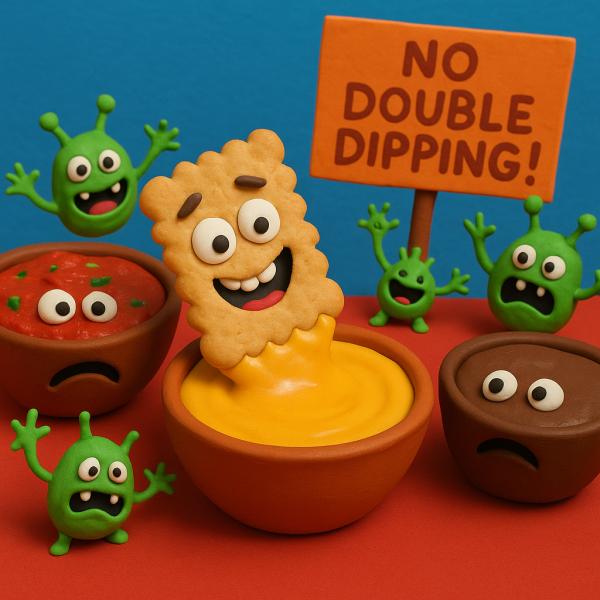
The dread double dip, re-dipping your already chewed-upon chip back in the dip. Made infamous on Seinfeld, a tongue-in-cheek study in Food Safety supports the findings that while it may be socially icky, even for your significant other, it will unlikely lead to illness. Succinctly, here is the question.
“How many bacteria are transferred from the perpetrator's mouth to the dip?”
The mouth is a primary gateway to our body and, as a result, has a microbiome, unlike any other area in our bodies. Estimates suggest anywhere from 500 to 700 bacterial species across 14 genera call our mouths their home. Some might be considered pathogenic, causing disease if they are found in other bodily sites, so it is a reasonable health concern that all that bacterial goodness can be transferred from our mouths to dips from already bitten chips.
A brief note for the tl:dr crowd, Ana Dolaskie, our videographer has a short video take on this study here.
The researchers used three commercially available dips (salsa, chocolate, and cheese) along with low-sodium wheat thins, acting as “the chip.” [1]
To analyze the impact of double-dipping, researchers began by characterizing the microbiome of their subjects, essentially culturing their saliva. [2]
- Experiment 1 – Participants bit a cracker and then dipped it in a sterile 0.1% peptone “broth” and cultured it. Unbitten chips dipped in the broth served as controls.
- Experiment 2 – The pH (acidity) of the store-bought dips was determined, and three sterile 0.1% peptone broths were adjusted to “determine the effect of pH on bacterial population in the dip without confounding the results with effects from other food dip components or properties.” Specimens were cultured for three treatments: no dip, the control dip, and the dreaded double dip.
- Experiment 3 – The salsa, cheese, and chocolate were replaced with the peptone broth, following the same no-dip, control-dip, and double-dip protocol. The changing weight in the dip containers determined the amount of dip on the chip.
And the Science Says …..
- Biting a cracker before dipping it into a communal sauce significantly increased bacterial transfer into the dip, while unbitten crackers transferred virtually no bacteria—even after multiple dips.
- Dips contaminated by bitten crackers consistently had higher bacterial levels than untouched controls. While acidic pH and time reduced bacterial survival somewhat, dips with neutral pH maintained high contamination over time.
- Dips exposed to double-dipping consistently showed significantly higher bacterial contamination, with stickier, more viscous sauces (such as cheese) transferring more bacteria due to greater dip adherence to the bitten cracker.
Double dipping, as common sense suggests, does contaminate the dip. However, before we wield the sword of science against the double-dipping infidels, there are some caveats. The components of the dip interact and impact the resulting bacterial transfer. Greater acidity, with a lower pH, suppresses bacterial contamination, while viscosity, which allows for a higher bacterial load, increases contamination. As with all biological systems, there is an underlying tradeoff: viscosity and dip adhesion can outweigh the protective antimicrobial role of low pH.
More importantly, while we can irrefutably state that double dipping contaminates the dip, it remains unclear “whether the type or amount of contamination is dangerous to a dippers' health…”
As the Washington Post, the impetus for this article notes, while respiratory illnesses (e.g., influenza, COVID, and the common cold) are readily transmitted from coughing and sneezing, they are not found to be transferred in food. That is not the case for the norovirus, which is easily transmitted through food. There is no settled science on the health impact of double dipping. In some social circles, the social science, i.e., etiquette, is settled, double dipping is wrong, crossing a subtle boundary, contaminating shared space.
[1] Sadly, we must report that all materials were consumed during experimentation.
[2] As the researchers write, “total aerobic bacteria in the mouths of the subjects were measured by rinsing each subject's mouth with 20mL of sterile then expectorated into a sterile bag.” You have to love scientific prose.
Source: Effect Of Biting Before Dipping (Double-Dipping) Chips On The Bacterial Population Of The Dipping Solution Journal of Food Safety DOI: 10.1111/j.1745-4565.2008.00137.x
Double-dipping may seem gross, but it’s not as risky as you think Washington Post



